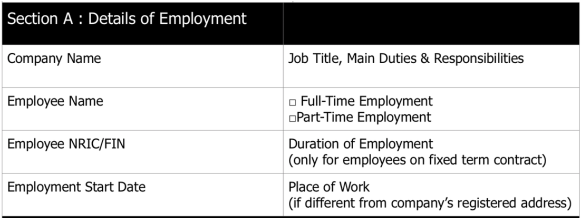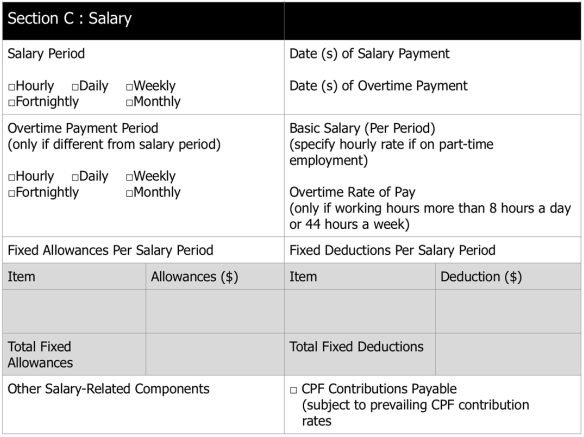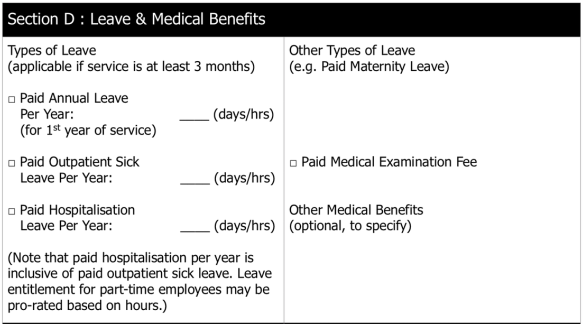Menu
Key employment terms (KET) template
From 1st April 2016, employers will be required to issue written Key Employment Terms (KET) & itemised payslips to their employees.
| key_employment_terms_template.pdf | |
| File Size: | 34 kb |
| File Type: | |
Who to issue key employment terms (KET) to:
- Newly employed workers who start work on or after 1 April 2016,
- Workers who are covered by the Employment Act*, &
- Workers who are employed for a continuous period of 14 days or more.
Key employment terms need to be issued within 14 days from the start of employment.
Key employment terms (KET) can be provided in either soft or hardcopy, & common key employment terms (e.g. leave policy that applies to a group of employees) can be provided in an employee handbook or company intranet.
KET must include the items below, unless an item is not applicable.
(For example, if the employee is a PME & overtime pay does not apply to him/her, the KETs issued to him/her need not include item 11 & 12.)
- Full name of employer,
- Full name of employee,
- Job title, main duties & responsibilities,
- Date of start of employment,
- Duration of employment (if employee is on fixed-term contract),
- Working arrangements (daily working hours e.g. 8.30am to 6.00pm, number of working days per week (e.g. 5? or 6?) & rest days (e.g. Saturdays & Sundays?),
- Salary period (what dates the payment for),
- Basic salary (For hourly, daily or piece-rated workers, employers should also indicate the basic rate of pay (e.g. $10 per hour, day or piece),
- Fixed allowances (Per salary period),
- Fixed deductions (Per salary period),
- Overtime payment period (If different from #7),
- Overtime rate of pay,
- Other salary-related components (e.g. bonuses & incentives),
- Leave (e.g. annual leave, outpatient sick leave, hospitalisation leave, maternity leave, childcare leave),
- Other medical benefits (e.g. insurance, medical/dental benefits),
- Probation period, &
- Notice period.
Tips on filling in the key employment template (KET):
When filling in section A :
- If the employee works less than 35 hours per week, he will be considered a part-time employee.
When filling in section B :
- Working hours refer to the agreed contractual working hours. The employee’s working hours cannot exceed 12 hours a day or 44 hours a week. This may be different for shift workers as long as the average hours worked over any continuous 3 week period does not exceed 44 hours a week. Hours of work do not include break time for tea/meals, rest & overtime hours.
- Employees are entitled to 1 rest day a week without pay. This rest day can fall on Sunday, or any other day as determined by the employer. If the employer needs the employee to work on a rest day, the employer must seek the employee’s agreement, & pay the employee 2 days of salary if he works more than half of the daily contracted working hours.
When filling in section C :
- Employers can choose to pay employees at the end of each working day, or on a weekly, or fortnightly, or monthly basis.
- Employers should pay employees at least once a month, & within 7 days after the end of the salary period. Employers should also pay employees their overtime pay within 14 days after his overtime payment period.
- In addition to basic wages & overtime pay, cash incentives, allowances, commissions & bonuses are subject to CPF contribution.
- Employee's basic salary excludes his allowances & overtime pay.
- When the employee works more than his contractual working hours, he should be paid overtime, at least 1.5X his hourly basic rate. Employees are not allowed to work more than 12 hours a day, or 72 hours overtime in a month.
- Employers cannot deduct more than 50% of their employee’s salary for fixed or once-off deductions.
When filling in section D :
- Refer to www.mom.gov.sg for the Employment Act statutory leave entitlement, & Child Development Co-Savings Act for family-related leave entitlement, applicable to both full-time & part-time employees.
- Employers must pay their employee’s medical consultation fees if the employee has worked for 3 months or more.
When filling in section E :
- Employers & employees may terminate the contract by giving notice to each other.
- The notice period should be the same for both employer & employee. If the notice period is not fixed, the default period in the Employment Act will apply. The employer or employee can choose to pay salary in place of the notice period.

Key employment terms (KET) FAQ
Click here to review the answers to frequently answered questions regarding key employment terms.
Click here to review the answers to frequently answered questions regarding key employment terms.
Location |
|





